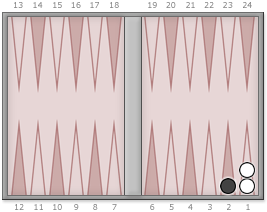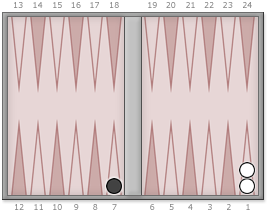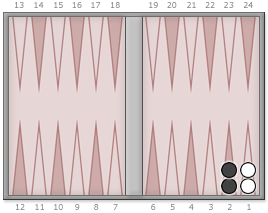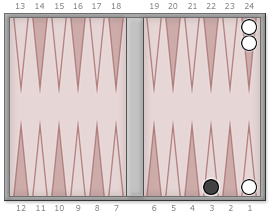This is the tenth in a series of posts I am writing about the game of hypergammon. The previous posts are [Hyper 01], [Hyper 02], [Hyper 03], [Hyper 04], [Hyper 05], [Hyper 06], [Hyper 07], [Hyper 08], and [Hyper 09].
Bearoff Wastage
I discussed wastage in Hyper 08. Wastage refers to the difference between (1) the number of pips distant your checkers are from being borne off and (2) the number of pips you expect to roll on your dice to get your checkers home and borne off.
Adding wastage to your pip count gives your effective pip count (epc).
The term “wastage” traditionally applies to no-contact positions and refers to the pips that go unused when you roll numbers higher than you can use as you bear off your last few checkers of a game. I am about to extend the meaning of wastage, so I will refer to traditional wastage as “bearoff wastage.”
Contact Wastage
The idea of wastage can be extended to contact positions. The concept is the same:
But the wastage in contact positions doesn’t come from bearing off; it comes from blocking and hitting.
Block-Wastage
Block-wastage refers to pips you roll that you can’t use because your checkers are blocked. Here is an example.
 | Example 1 2 v 24,24 |
If black is unlucky enough to roll 1-1, he won’t be able to move, and all of the 4 pips he rolls will be wasted. The immediate cost of this possibility is 4 pips in 36 rolls, or 0.11111 pips on average.
Here is another example.
 | Example 2 7 v 24,24 |
There are many ways black can be blocked here. Rolling 6-6 loses 24 pips, 3-3 loses 9 pips, 2-2 loses 4 pips, 4-2 loses 2 pips, and 5-1 loses 1 pip. That’s a total of 43 pips out of 36 rolls, for an average of 1.1944 pips that black can expect to lose on his next roll.
In these two examples, we calculated black’s immediate block-wastage. Black’s total block-wastage is higher than that because he might be blocked again later in the game.
- Black’s total block-wastage in Example 1 is 0.11137.
- Black’s total block-wastage in Example 2 is 1.19990.
Hit-Wastage
Hit-wastage refers to pips you expect to lose from having your blots hit and sent to the bar. Hit-wastage depends on: (1) how likely you are to be hit, and (2) how far back your blots are sent when they are hit.
(It may seem a strange use of the term “wastage” to quantify the danger of being hit, but it is convenient to group hit-wastage, block-wastage, and bearoff-wastage together. Pips lost to a hit must be made up by throwing additional rolls later so in some sense you are wasting pips by leaving blots where they can be hit.)
Here is an example of hit-wastage:
 | Example 3 2,2 v 24,24 |
On black’s next roll, he will leave a blot with any roll containing a 1 (except 1-1). That’s 10/36 rolls. When black leaves a blot, white will hit it with 11 of his 36 rolls. When black gets hit, his checker is sent back 23 pips. Let’s multiply that out:
Black expects to lose 1.95216 pips on average over the next exchange of rolls.
Black’s total hit-wastage in this position is higher than that because he might be hit again later in the game, maybe several times. His total hit-wastage in Example 3 is 3.08619 pips.
Defining Best Play
There is one further detail we need to nail down before we can measure contact wastage in a consistent manner: How exactly will the game be played out?
Generally we assume both sides play to maximize their own equity, but sometimes there is a tie — sometimes two or more plays have the same equity. How do we break ties? Here is the policy I use:
1. If two plays are tied in equity, choose the play that leads to the least expected rolls for the game.
2. If there is still a tie, choose the play that minimizes total epc.
(This is a somewhat recursive definition. To calculate wastage, you need to know how to play every roll. But to know how to play every roll, you need to be able to measure wastage. Fortunately, this is not a problem in practice.)
We saw an example in Hyper 08 of where tie-breaking is needed:
 | Example 4 Black rolls 2-1 |
Black has a choice of playing 3/1*/off (hitting) or 3/off (not hitting). Both choices yield the same equity (3 points for black). Both choices play out to the same number of rolls (1). To break the tie, we look at total epc. Black’s epc is the same either way, but white’s epc is higher if black hits. So we break the tie by choosing the nonhitting play for black.
Computing Wastage
Either player’s total wastage is the sum of his bearoff-wastage, his block-wastage, and his hit-wastage:
The wastage of a given position can be computed in two parts: Take the current wastage of the position and add the future wastage of the position.
The current wastage of a position comes from the next roll. Look at each of the 36 possible rolls and observe the difference between the number of pips that are rolled and the number of pips that are played. In the case of a hit, observe the distance any hit checker is sent back and charge that as hit-wastage for the opponent.
Future wastage is everything else — all the wastage after the next roll. You compute it by averaging the wastage of the 36 positions that result from the current roll.
Average Wastage in Hypergammon
The following chart shows the average wastage you can expect to see in a game of hypergammon. “Player 1” is the player that wins the opening roll. “Player 2” is the player that loses the opening roll.
| Bearoff | Block | Hit | First Roll | Total | |
| Player 1: | 6.65775 | 0.38932 | 34.84799 | 1.16667 | 43.06173 |
| Player 2: | 6.58864 | 0.39727 | 33.10735 | 40.09325 | |
| Total: | 13.24639 | 0.78659 | 67.95534 | 1.16667 | 83.15498 |
| Average: | 6.62319 | 0.39330 | 33.97767 | 0.58333 | 41.57749 |
There are many tidbits of information to be gleaned from this chart.
- The average bearoff-wastage per player in a game of hypergammon game is 6.62318 pips. This is less than it is in backgammon. (Backgammon’s minimum bearoff-wastage with 15 checkers is 7.06895, so the average wastage would be even higher than that.) That’s as you’d expect; every additional checker on the board is one more that can get caught up in a wasteful roll at the end of the game.
- Block-wastage in hypergammon is very low, less than half a pip per player for the whole game. Blocking is not a big factor in hypergammon. After all, the best block you can make is a single point and that’s not going to slow down your opponent very much.
- Hit-wastage makes up the vast majority of the wastage in hypergammon. Eighty-two percent of all wastage comes from blots being hit.
- There is a curious number in this chart that needs explanation. In the column “First Roll,” you see the number 1.16667. This is a kludge to account for the fact that the first roll of a game cannot be doublets.
Normally we assume an average of 8.16667 pips per roll, but that doesn’t hold for the first roll of the game, where the average is just 7 pips. To make up the difference, we add 1.16667 pips to Player 1’s wastage.
- The total wastage per player in hypergammon is 41.57749 pips. Your effective pip count (epc) is the sum of your regular pip count and your wastage. At the start of a game, your pip count (pc) is 24 + 23 + 22 = 69, so your effective pip count is: epc = pc + wastage = 69 + 41.57749 = 110.57749
Effective pip count can be converted to number of rolls by dividing by 49/6:
epc ÷ (49/6) = 13.45010 rollsThat means, from the start of a game, it takes an average of 13.45010 rolls to bring your checkers home and bear them off.
(To be continued.)